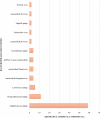A pilot metagenomic study reveals that community derived mobile phones are reservoirs of viable pathogenic microbes
- PMID: 34239006
- PMCID: PMC8266881
- DOI: 10.1038/s41598-021-93622-w
A pilot metagenomic study reveals that community derived mobile phones are reservoirs of viable pathogenic microbes
Abstract
There is increasing attention focussed on the risks associated with mobile phones possibly serving as 'Trojan Horse' fomites for microbial transmission in healthcare settings. However, little is reported on the presence of microbes on community derived mobile phones which in 2021, numbered in the billions in circulation with majority being used on a daily basis. Identify viable microbial organisms swabbed from smartphones on a university campus. Entire surfaces of 5 mobile phones were swabbed and examined for their microbial content using pre-agar-based growths followed by downstream DNA metagenomic next-generation sequencing analysis. All phones were contaminated with viable microbes. 173 bacteria, 8 fungi, 8 protists, 53 bacteriophages, 317 virulence factor genes and 41 distinct antibiotic resistant genes were identified. While this research represents a pilot study, the snapshot metagenomic analysis of samples collected from the surface of mobile phones has revealed the presence of a large population of viable microbes and an array of antimicrobial resistant factors. With billions of phones in circulation, these devices might be responsible for the rise of community acquired infections. These pilot results highlight the importance of public health authorities considering mobile phones as 'Trojan Horse' devices for microbial transmission and ensure appropriate decontamination campaigns are implemented.
Conflict of interest statement
The authors declare no competing interests.
Figures








References
-
- McCalla S, Thomas R, Reilly M. Hand hygiene compliance:“Going Back to Basics”. Am. J. Infect. Control. 2014;42(6):S134. doi: 10.1016/j.ajic.2014.03.288. - DOI
MeSH terms
Substances
LinkOut - more resources
Full Text Sources
Medical

